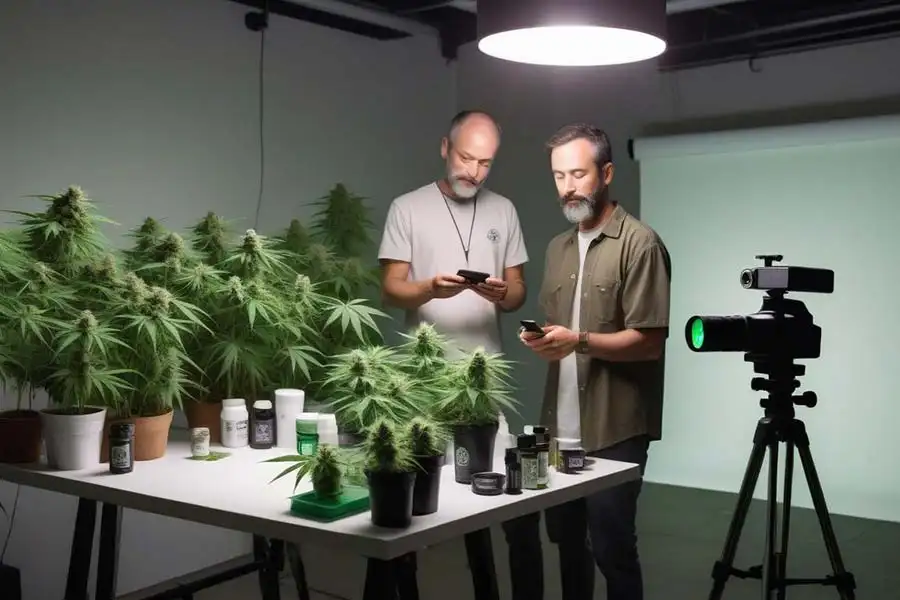Like any other form of marketing or sales, e-commerce images are crucial for the effective selling of cannabis products. E-commerce images act as the first impression, shaping customer perceptions and driving purchase decisions. Captivating product photos and lifestyle shots play a crucial role in boosting conversions.
This blog explores ways you can create impactful visuals of your cannabis products, and avoid common mistakes. It covers sourcing options, optimization strategies, and how VFI Technology can help you get the best cannabis e-commerce images.
Importance of Cannabis E-commerce Images
So, why are e-commerce images so important?
1. Customers WANT To See Images
In an online setting, trust is crucial. Since customers can’t physically touch or inspect products, images become the bridge between the product and customer satisfaction. High-quality, clear images give customers confidence that what they see is what they will get, minimizing returns and increasing customer loyalty.
2. Quality Cannabis Images Improve E-commerce Sales
It’s no secret that great visuals increase sales. Cannabis e-commerce studies have shown that product images can improve conversion rates by up to 30%.
Clear, detailed photos provide the information customers need to make informed decisions. When customers see what they are purchasing, they’re more likely to buy with confidence.
3. Good Images Support Brand Identity
Images go beyond showcasing cannabis products — they convey your brand’s values and style. Thoughtfully crafted, consistent visuals help establish a distinct identity, setting your brand apart in a competitive market. Does your cannabis brand exude luxury, embrace a playful vibe, or champion sustainability? Your imagery can subtly reflect and reinforce these traits, creating a deeper connection with your audience.
4. Optimized Images Improve Page Loading Speeds
Large images can significantly slow down page load time, which may affect both user experience and SEO. With proper optimization, images can improve page load speeds. They also enhance accessibility and provide search engines with additional context about your content. Optimizing images to be the minimum Kb-sizes without distorting quality and sharpness is vital to improving page load speeds. Use newer file format formats like AVIF or WEBP for the best balance of quality and compression.
Dos and Don’ts of E-Commerce Images
Dos
1. Use High-Resolution Images
Clear, high-quality images are a must. Blurry or pixelated photos can make your website look unprofessional, affecting trust and sales. Aim for high-resolution images without being too large in file size, to ensure fast loading times without sacrificing quality.
Tip: Use formats like AVIF or WEBP, which offer a balance between quality and compression.
2. Show Multiple Angles and Zoom Options
Customers want to inspect products from every angle. Well-crafted images are essential to closing a sale. They serve as a silent salesperson, showing features, that text descriptions alone can’t convey.
Providing multiple images from different perspectives, including close-ups, helps users see details they might otherwise miss. A zoom feature can further enhance the shopping experience, allowing customers to view textures and intricate details up close.
Tip: Ensure that the zoom feature shows high-quality details rather than pixelation when enlarged.
3. Create a Consistent Style
Consistency across images adds a cohesive, professional look for your e-commerce site. Use the same background (often white or soft gradients), lighting, and aspect ratio for all products. This uniformity makes the browsing experience smoother and more appealing.
Tip: For a polished look, use natural lighting or soft studio lighting, and avoid harsh shadows or inconsistent color tones.
4. Incorporate Lifestyle Shots
Lifestyle images effectively showcase products in authentic settings, making them more relatable and visually appealing. For example, this picture features Kiva’s cannabis-infused chocolates alongside fresh ingredients that reflect the flavors of the products. This thoughtful arrangement highlight the chocolates’ appeal and evoke a sense of imagined flavor, inviting customers to envision the experience. Whether displayed on a website banners, blogs, or product pages, such images inspire indulgence and aspiration.
5. Images Should Tell a Story
Cannabis e-commerce images do more than showcase products — they tell your brand’s story. For example, a lifestyle image doesn’t just highlight a pre-roll; it captures it in the hands of someone enjoying a serene evening by the campfire or a vibrant gathering with friends. Such visuals connect with the viewer’s aspirations, reflecting the experiences and lifestyle your brand embodies.
Use your images to subtly communicate the values and lifestyle your cannabis brand promotes, making them an integral part of your storytelling.
Don’ts
1. Avoid Stock Photos for Key Products
Stock photos can feel generic and may not accurately represent your brand or products. Authentic, unique images are more effective in building trust. Even if it requires a little more investment, original product photography will have a greater impact on customer perception.
Tip: If stock images are necessary, consider using them only for blog posts or secondary content, not primary product images.
2. Don’t Overload on Graphics or Text
Adding too many graphics, badges, or text overlays can make an image look cluttered. While a promotional badge here or there might be okay, keep it minimal and tasteful. The product itself should remain the focal point.
Tip: Use graphic overlays sparingly and avoid text-heavy images. Keep important information in the product description instead.
3. Avoid Over-Adding or Artificial Effects
Over-saturated colors or overly edited images can create a misleading impression of the product. It’s essential to keep edits subtle and realistic so that customers aren’t disappointed when they receive the item.
Tip: Avoid filters that drastically change color or texture. Instead, focus on subtle color correction and sharpness.
4. Avoid Cluttered Backgrounds, Use White Instead
A cluttered or busy background distracts from the product. Stick to simple, clean white backgrounds that allow the product to stand out. Most e-commerce sites use plain white or neutral backdrops to ensure the product remains the center of attention.
Tip: If you want a pop of color, use a gradient or soft pattern that doesn’t compete with the product.
Using Images to Enhance Customer Experience in E-commerce
Images play a direct role in the customer journey. From the initial click to the final checkout, visuals guide and reassure customers about their purchase decisions. High-quality images can reduce doubts, inspire confidence, and reduce returns by accurately representing products.
At VFI Technology, we understand that e-commerce success requires more than just functionality. We support clients with well-optimized images to create visually appealing, optimized product listings that drive sales. Our services include:
- Image Optimization: Have our team resize, compress, and format images to ensure fast load times and great quality.
- SEO Support for Images: Our SEO experts help clients optimize alt text, captions, and file names to boost search rankings.
- Expert Advice on Visual Content: From photography tips to layout guidance, our team is available to support cannabis e-commerce clients in creating images that convert.
Sourcing Images for E-Commerce
When it comes to creating visually appealing e-commerce websites, the right images are as important as the products themselves. Budget, brand needs, and product type define how you choose images! You could connect with brands and growers for their existing custom images, create custom images of your own; or even use stock imagery for some of the content. Most site owners end up using a mix of all three. Here’s a breakdown:
Source High-Quality Images from the Brands Themselves
Collaborating directly with cannabis growers and brands is a straightforward way to source high-quality, authentic product images for your e-commerce site. Many cannabis brands invest in professional photography and licensing agreements, ensuring their images are visually appealing and compliant with regulations.
Why Source Images from Brands?
- Consistency with Branding: Using official product images ensures that your website reflects the product packaging and branding accurately, avoiding any misrepresentation.
- Professional Quality: Brands often hire professional photographers, resulting in high-resolution, polished visuals that elevate the look of your site.
- Save Time and Money: Instead of organizing photoshoots, you can save time and money by leveraging the existing resources provided by brands. In fact, the lifestyle images created by some brands can be a great source of visual inspiration for banners and promotional material.
- Regulatory Compliance: Licensed images are likely to adhere to cannabis industry advertising and labeling regulations.
How to Get Images from Brands
- Contact Your Suppliers: Reach out to the cannabis brands you stock on your e-commerce platform. Most suppliers have a media kit or a library of images ready to share with their retail partners.
- Request Licensed Images: Ask for product shots, packaging images, and lifestyle photos, if available. These are often created for promotional use and can easily be integrated into your website.
- Build a Relationship: Establishing strong communication with brands not only helps you get images but also opens doors for co-marketing opportunities and cross-promotions.
- Clarify Usage Rights: Confirm whether the images are licensed for online use, and be clear about where and how you plan to use them (e.g., product pages, banners, or social media).
Pro Tip:
While waiting for brands to provide their images, prioritize setting up placeholder visuals. Use stock photos labeled “Coming Soon” or generic cannabis imagery to avoid disrupting the user experience.
Customized Images: Tailored for Your Brand
Customized photoshoots allow businesses to create unique visuals that perfectly align with their brand identity.
Advantages:
- Enhanced Customer Trust: Real, detailed images build authenticity and trust.
- Flexibility: You have complete control over lighting, angles, and styling.
When to Use:
- For product pages, lifestyle images, or marketing campaigns, showcasing your specific product is essential.
Best Practices for Photoshoots:
- Hire Professionals: Invest in experienced photographers and stylists.
- Plan the Shots: Create a shot list covering various angles, close-ups, and lifestyle contexts.
- Focus on Lighting: Good lighting can make or break an image. Natural light works well for most products, but studio lighting is ideal for consistency.
Shooting Great Cannabis E-commerce Images Using Mobile Phones
Mobile photography has advanced significantly, making it possible to capture professional-quality images with just a smartphone.
For cannabis e-commerce, visually appealing and accurate product images are crucial to attract customers, build trust, and enhance sales. Here’s how you can master cannabis photography using your mobile phone.
1. Set Up a Clean and Consistent Background
A clean background keeps the focus on the cannabis product. Use neutral colors like white or gray to ensure the product stands out. Portable lightboxes or DIY setups with white poster boards work well. If you’re aiming for lifestyle shots, ensure the background complements the product, such as natural wooden textures or minimalistic decor.
2. Optimize Lighting for Clarity
Proper lighting is critical in capturing the fine details of cannabis products. Natural light works best for softer, even illumination. Position the product near a window with diffused sunlight. For artificial lighting:
- Use softboxes, LED panels, or ring lights to reduce harsh shadows.
- Avoid overhead lighting that can create unflattering shadows or reflections.
- Ensure that the light highlights the product’s color, texture, and trichomes.
3. Stabilize Your Camera
Shaky images appear unprofessional. Use a tripod to stabilize your phone and maintain consistency across shots. A simple clamp tripod for smartphones is affordable and effective.
4. Master Camera Settings
Most modern smartphones allow manual adjustments to camera settings:
- Focus: Tap to focus on key details like trichomes or buds.
- Exposure: Adjust exposure to avoid overexposure or underexposure.
- White Balance: Ensure accurate color representation by setting the correct white balance.
If your phone has a Pro or Manual mode, use it to fine-tune ISO, shutter speed, and focus for sharper results.
5. Use Macro Mode for Close-Up Shots
Cannabis customers often look for detailed close-ups to assess quality. Many smartphones have macro modes that allow extreme close-ups without losing focus. Highlight trichomes, textures, and the unique structure of buds to captivate your audience.
6. Pay Attention to Composition
Follow photography principles like the rule of thirds to create balanced compositions. Center shots are best for detailed images, while lifestyle shots can benefit from creative framing. Experiment with angles, but avoid over-complicating the frame — simplicity sells.
7. Edit Thoughtfully
Editing enhances images but should never mislead customers. Use apps like Lightroom or Photoshop to:
- Adjust brightness, contrast, and sharpness.
- Remove minor distractions or blemishes.
- Maintain natural colors to reflect the product’s true appearance.
8. Showcase the Packaging
Many customers care about branding and packaging. Capture high-quality images of product jars, labels, and branding materials. Ensure the text on labels is readable and crisp. Customers often have favorite brands. Showcasing a label could quite well mean closing a sale in a matter of seconds!
9. Include Lifestyle and Contextual Shots
Lifestyle images connect with customers by showing products in real-life contexts. For cannabis, you could display the product near rolling papers, grinders, or in natural settings like patios or gardens.
10. Experiment with Props
Minimal props like jars, scales, or small plants can make your images more engaging. However, they should not overpower the main product. Props should highlight, not distract from, the cannabis.
Stock Photography: Affordable and Quick
Stock photography provides an easy and cost-effective way to source high-quality images. These images are pre-shot and available on platforms like Shutterstock & Adobe Stock. Moreover, sites such as Freepik and Unsplash offer many free images options for you to download and use!
Advantages:
- Affordable: Suitable for small businesses with tight budgets.
- Time-Saving: Instantly available without the need for a photo shoot.
- Versatile Options: A wide range of images covering nearly every industry.
When to Use:
- For blog posts, banners, or secondary website content where specific branding isn’t necessary.
Limitations:
- Lack of Exclusivity: The same images may appear on competitors’ websites.
- Generic Appeal: Stock images often lack the personal touch needed to showcase unique products.
Conclusion: The Power of High-quality Images
In cannabis e-commerce, images are essential tools that bridge the gap between your products and customers. High-quality, optimized e-commerce images build trust and spell out quality. Moreover, they also improve SEO and elevate the shopping experience, guiding customers confidently from browsing to buying.
Whether you choose stock photography or custom photoshoots, the right visuals can boost conversions and reinforce your brand identity. At VFI Technology, we help businesses maximize the potential of their imagery through expert guidance, seamless integration, and optimization. In today’s competitive market, every image tells a story — ensure yours resonates with your audience and drives success.



